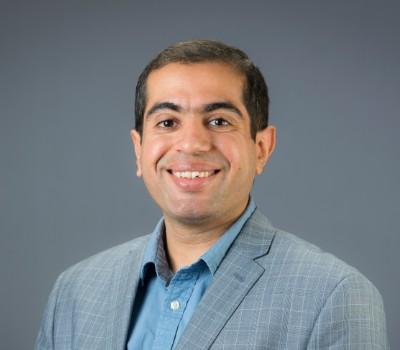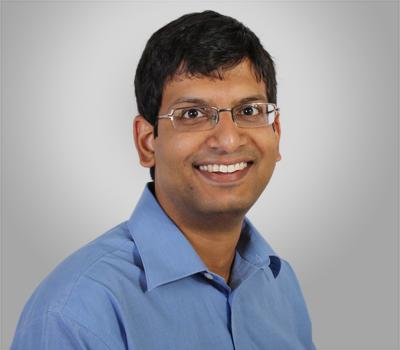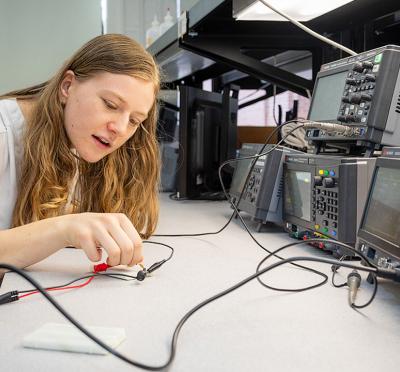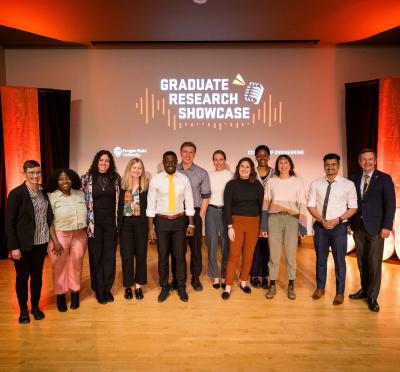Graduate students Anindita Borah (seated) and Kamala Raghavan work with the equipment donated by Tektronix. Watching are Tejasvi Anand (far right), assistant professor of electrical and computer engineering, and Tom Weiss, strategic account manager at Tektronix.
Engineering students and faculty are benefiting from recent donations of state-of- the-art testing equipment from Tektronix Inc., a leading global provider of test, measurement, and monitoring instrumentation based in Beaverton, Oregon. The donations, which included equipment donations in addition to discounts on equipment, were part of a $1 million upgrade to the Analog/Mixed Signal Lab in the School of Electrical Engineering and Computer Science. The upgrade is enabling researchers to impact a broad range of disciplines, including consumer electronics and radiation detection.
The decades-long partnership between Tektronix and Oregon State continues to fuel academic excellence and produce innovative, industry ready graduates. The company’s earlier support includes a previous equipment upgrade and other donations that support innovative education. “Tektronix is committed to giving back to the community, and our involvement with Oregon State is of strategic importance for the future of engineering,” said Brandon Greenley (’01 M.S., Electrical and Computer Engineering), vice president and general manager at Tektronix. “We want the best and brightest to work for Tektronix, and a big part of that is making sure that people have experiences and exposures to us as a company.”
As an Oregon State graduate, Greenley experienced firsthand how industry partnerships impact students.
“I benefited greatly from Tektronix’s involvement with Oregon State,” said Greenley. His experience as an undergraduate and master’s student ultimately led to his employment there.
The crown jewel in the equipment upgrade is a new bit error rate tester (BERT), which tests new electronic devices to see how many errors are made during the transmission of a signal. In a lab where researchers are pushing the boundaries of data transmission speed, it is critical to have a device that can test at high rates. BERT can test at 28.6 gigahertz, which is more than double the lab’s previous capacity.
In less than a year, researchers in the lab have published five papers for which the Tektronix equipment was essential. One paper, presented at the IEEE International Solid-State Circuits Conference, was made possible by having access to BERT. Arun Natarajan and Tejasvi Anand, assistant professors of electrical and computer engineering, co-authored the paper with Ashwin Ramachandran, a graduate student in electrical and computer engineering.
Another paper, which was nominated for the Best Student Paper award at the IEEE International Microwave Symposium, highlighted research conducted by graduate students Kai Zhan and Ashwin Ramachandran. Both papers demonstrated proof of concept for new techniques in transmitting a signal over a channel, with the goal of improving the speed and power efficiency of lower-cost components.
Tektronix also donated a parameter analyzer used to measure ultra-low-level currents and voltages for semiconductor devices, enabling a higher level of accuracy and resolution.
“Without it, we can’t effectively characterize our devices, and if we can’t characterize our devices, we can’t build circuits around them and ultimately build complete sensor systems. So this is the first step in that chain,” said Matt Johnston, assistant professor of electrical and computer engineering. Johnston’s research includes chemical and biological sensing for applications such as air quality monitoring and medical diagnostics.
Most laboratories on campus are specifically set up to support the work of one researcher and the graduate students under that researcher’s guidance.
The Analog/Mixed Signal Lab is unique because it supports the work of nine professors and approximately 40 graduate students. Undergraduate students also have access to the equipment for senior design projects, so it has already seen heavy use.
“I’ve been in a traditional single faculty lab before, so I know how the equipment would sit on the shelf. In our lab, there is a constant stream of students,” said Natarajan.
In addition to the Tektronix donations, the upgrade was made possible by a combination of faculty research funds, the College of Engineering, the School of Electrical Engineering and Computer Science, and the Research Office at Oregon State.
MOMENTUM, College of Engineering, Fall 2017
MOMENTUM Issue Archives
Questions: editor@engr.oregonstate.edu





